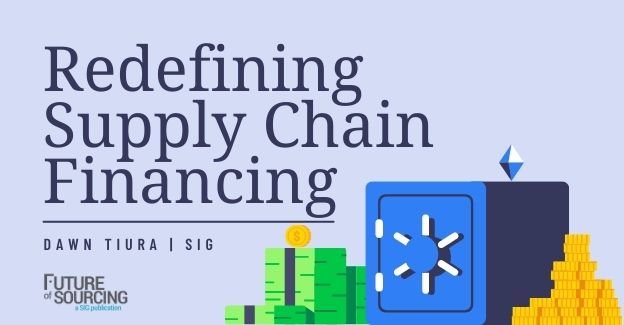Supply chain financing is a win-win strategy for buyers and suppliers, says Dawn Tiura, CEO and President of Sourcing Industry Group (SIG). She shares three ways that supply chain financing (SCF) can help mitigate rising costs due to inflation and reduce friction when it comes to paying supplier invoices on time.
“SCF can assist firms and their supply chains by increasing the velocity of cash flow and making those flows more consistent. Implemented properly, the firm and its supply chains can enjoy a symbiotic relationship.” - Supply Chain Financing and Pandemic: Managing Cash Flows to Keep Firms and Their Value Networks Healthy, Rutgers Business Review (2021)
In my previous article, I discuss how transparency creates the “necessary trust to tame inflation" by strengthening the relationship between buyers and suppliers to ensure “a fair distribution of costs and profits.” This “fair distribution” goes beyond negotiating a win-win price for all stakeholders – which is important; it also includes, among other things, the timely payment of invoices.
In the context of Rutgers’ paper, timely payments will increase the "velocity of cash flow," including making them "more consistent.” With the pandemic and now the war in Ukraine, consistency of anything is for many an elusive quest. Growing uncertainty is now the order of the day, and due to these devastating global events, our supply chains are stretching to the breaking point. As a result, finding savings that can reduce costs and improve the bottom line is more important now than perhaps ever before.
If you have been in this industry for as long as I have, you are likely familiar with the term supply chain finance or financing (SCF). The concept is not new. The problem is understanding what SCF actually is and the expanded scope of its impact – especially during periods of market turmoil.
Supply chain finance is a set of tech-based business and financing processes that lower costs and improve efficiency for the parties involved in a transaction.
Often erroneously limited to reverse factoring/factoring, SCF, according to Rutgers, "encompasses a broader class of solutions that provide net working capital (NWC) and trade financing to firms and their supply chains.” In other words, SCF is more than financing receivables as it involves several key supply chain activities that can indirectly impact rising costs.
This article will look a little closer at these SCF solutions.
Inbound Supply Chain (Accounts Payable)
The Rutgers paper identifies the use of purchasing cards (P-cards), purchase order financing, dynamic discounting and reverse factoring as inbound supply chain solutions.
Of course, none of the above “solutions” are in and of themselves new.
For example, by taking “advantage of the existing credit card infrastructure to make electronic payments,” P-cards offer more than speed and convenience. They streamline the procurement process leading to a reduction in processing costs. This last point is key, as research indicates that the processing “cost of a $25 purchase is the same as a $10,000 purchase.”
Beyond the transactional savings, P-cards make cash flow management more efficient, improve reconciliation and allow greater transparency.
Initially used for low-dollar, high-transaction items, there are indications that P-card usage is expanding regarding higher dollar amount purchases brought about in part by the introduction of virtual cards.
Outbound Supply Chain (Accounts Receivable)
Outbound supply chain solutions include collective invoices, sales offer financing, invoice discounting and factoring.
Let’s look at the benefits of collective invoicing.
Collective invoices are used to pay suppliers who provide a regular service over a more extended period. It is an efficient way to lower processing costs for buyers and suppliers because it compresses the number of individual (smaller) transactions into a single invoice.
By reducing the number of transactions to a single, collective invoice, transaction fees are lowered, saving time and money.
On/Off Balance Inventory
What is the difference between on-balance sheet and off-balance sheet inventory financing? The former utilizes what the Rutgers’ paper calls an asset-based lending approach in which the ownership of the goods in inventory is on the buying company’s books and used as collateral.
With the latter, inventory financing involves the transfer of “operational goods, logistics and ownership” to an external, third-party logistics service provider.
According to a September 2020 Supply Chain Digital article regarding how to lower supply chain costs, “warehousing and storage have to be fully optimized as part of a larger supply chain strategy.”
About Rising Costs
Beyond the positive impact on creating cash flow velocity, SCF can reduce hidden costs within your organization and impact the bottom line.
While it may not lower the actual costs of goods – at least not directly, it will enable you to find greater efficiency and savings through improved financing and processing.









